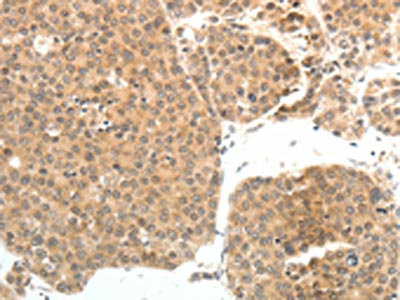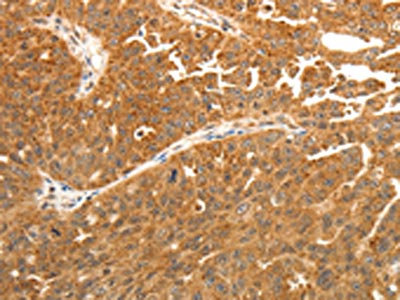
The image on the left is immunohistochemistry of paraffin-embedded Human ovarian cancer tissue using CSB-PA697643(PSMD7 Antibody) at dilution 1/20, on the right is treated with fusion protein. (Original magnification: x200)
PSMD7 Antibody

CSB-PA697643
ApplicationsELISA, ImmunoHistoChemistry
Product group Antibodies
ReactivityHuman
TargetPSMD7
Overview
- SupplierCusabio
- Product NamePSMD7 Antibody
- Delivery Days Customer20
- ApplicationsELISA, ImmunoHistoChemistry
- CertificationResearch Use Only
- ClonalityPolyclonal
- ConjugateUnconjugated
- FormulationLiquid
- Gene ID5713
- Target namePSMD7
- Target descriptionproteasome 26S subunit, non-ATPase 7
- Target synonyms26S proteasome non-ATPase regulatory subunit 7; 26S proteasome regulatory subunit rpn8; 26S proteasome regulatory subunit S12; Moloney leukemia virus-34 proviral integration; MOV34; Mov34 homolog; P40; proteasome (prosome, macropain) 26S subunit, non-ATPase, 7 (Mov34 homolog); proteasome subunit p40; Rpn8; S12
- HostRabbit
- IsotypeIgG
- Protein IDP51665
- Protein Name26S proteasome non-ATPase regulatory subunit 7
- Scientific DescriptionThe 26S proteasome is a multicatalytic proteinase complex with a highly ordered structure composed of 2 complexes, a 20S core and a 19S regulator. The 20S core is composed of 4 rings of 28 non-identical subunits; 2 rings are composed of 7 alpha subunits and 2 rings are composed of 7 beta subunits. The 19S regulator is composed of a base, which contains 6 ATPase subunits and 2 non-ATPase subunits, and a lid, which contains up to 10 non-ATPase subunits. Proteasomes are distributed throughout eukaryotic cells at a high concentration and cleave peptides in an ATP/ubiquitin-dependent process in a non-lysosomal pathway. An essential function of a modified proteasome, the immunoproteasome, is the processing of class I MHC peptides. This gene encodes a non-ATPase subunit of the 19S regulator. A pseudogene has been identified on chromosome 17.
- ReactivityHuman
- Storage Instruction-20°C or -80°C
- UNSPSC12352203

